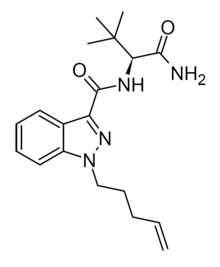|
ADB-4en-PINACA
ADB-4en-PINACA is a cannabinoid designer drug that has been found as an ingredient in some synthetic cannabis products,[1] first appearing in early 2021. It is a reasonably potent cannabinoid agonist in vitro but has not been so widely sold as related compounds such as ADB-PINACA and MDMB-4en-PINACA.[2][3][4][5] LegalityIn the United States, the DEA has temporarily placed ADB-4en-PINACA into Schedule I status starting on December 12th, 2023 for up to 2 years, during which it's possible the DEA could file for permanent scheduling within those 2 years. If the DEA does not file to permanent placement the temporary Schedule I order will expire on December 12th, 2025.[6] See alsoReferences
|
||||||||||||||||||||||||||||||||
